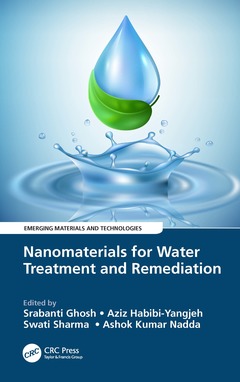Nanomaterials for Water Treatment and Remediation Emerging Materials and Technologies Series

Offering a comprehensive view of water-treatment technologies, Nanomaterials for Water Treatment and Remediation explores recent developments in the use of advanced nanomaterials (ANMs) for water treatment and remediation. In-depth reaction mechanisms in water-treatment technologies, including adsorption, catalysis, and membrane filtration for water purification using ANMs, are discussed in detail. The book includes an investigation of the fabrication processes of nanostructured materials and the fundamental aspects of surfaces at the nanoscale. The book also covers the removal of water-borne pathogens and microbes through a photochemical approach.
FEATURES
- Explains various chemical treatments for the removal and separation of hazardous dyes, organic pollutants, pharmaceuticals, and heavy metals from aqueous solutions, including adsorption, advanced oxidation process, and photocatalysis
- Discusses the rational design of nanoporous materials with a tunable pore structure and fabrication of nanomaterials by surface chemistry engineering
- Covers the role of nanomaterials-assisted oxidation and reduction processes, design of nano-assisted membrane-based separation, and multifunctional nanomaterials and nanodevices for water treatment
- Provides an understanding of the structure?activity relationship and stability of ANMs under critical experimental conditions
- Identifies potential challenges in the application of multifunctional ANMs for future research
Nanomaterials for Water Treatment and Remediation is aimed at researchers and industry professionals in chemical, materials, and environmental engineering as well as related fields interested in the application of advanced materials to water treatment and remediation.
1. Advancement of Nanomaterials for Water Treatment 2. Enhancement in Degradation of Antibiotics Using Photocatalytic Semiconductors under Visible Light Irradiation: A Review 3. Graphitic Carbon Nitride-Based Nanomaterials as Photocatalysts for Organic Pollutant Degradation 4. 2D Materials for Wastewater Treatments 5. TiO2-Based Nanomaterial for Pollutant Removal 6. Nanomaterials for the Removal of Heavy Metals from Water 7. Photoactive Polymer for Wastewater Treatment 8. Plasmonic Nanomaterials for Remediation of Water and Wastewater 9. Magnetic Nanomaterials for Wastewater Remediation 10. Nanofiber Membranes for Wastewater Treatments 11. Carbon Nanomaterials for Removal of Pharmaceuticals from Wastewater 12. Metal–Organic Frameworks and Their Derived Materials in Water Purification 13. Photocatalytic Mechanism in Low-Dimensional Chalcogenide Nanomaterials: An Exciton Dynamics Insight 14. Emerging Semiconductor Photocatalysts for Antibiotic Removal from Water/Wastewater
Date de parution : 12-2021
15.6x23.4 cm
Thèmes de Nanomaterials for Water Treatment and Remediation :
Mots-clés :
Anatase TiO; Visible Light Irradiation; Photocatalytic Activity; Photocatalytic Degradation; Graphene Oxide; Photocatalytic Performance; Maximum Adsorption Capacity; American Chemical Society; BN Nanosheet; Iron Oxide Nanoparticles; Max Phase; TFC Membrane; Nanofiber Membrane; Thin Film Nanocomposite Membranes; Photocatalytic Ozonation; Forward Osmosis; Magnetic Solid Phase Extraction; MOFs Synthesis; Ag NPs; ZVI Nanoparticles; Bismuth Oxyhalides; BNNTs; Bismuth Vanadate; Semiconductor Photocatalysts; MOFs



